Losing a competitive advantage? Objectives of combating IEDs
The NITTEK subsurface radar installed on the HUSKY engineering armored car (together forming the HMDS - HUSKY Mounted Detection System based detection system), during its operation, found countless non-metallic and metallic threats in the form of IEDs and ordinary mines. The system is among the priority programs of the US Army and Marine Corps and is expected to be included in the defense budgets of the coming years.
The Americans and their allies were late in reaching a balance in the fight against the threat of improvised explosive devices (IEDs) on the battlefields of Iraq and Afghanistan. In an era of universal cuts in defense budgets, it is imperative to continue the short-term and long-term search for technology in order to gain superiority in this area.
Help
IED is weapon cottage industry, which ranges from small tubes filled with military explosives to directional land mines with mineral fertilizers weighing tens of kilograms. IEDs have been annoying to the military for years. Despite the many implemented decisions, invested funds or neutralized goals of the VCA continue to be the main cause of losses in contemporary conflicts.
The complexity and scale of the fight against IEDs are forced to create many different strategies, technologies and teaching methods. The ability to neutralize a device and simultaneously attack a network of terrorists is absolutely necessary to prevent attacks related to IEDs and indirect losses.
The article provides an overview of the relevant aspects of this complex problem and raises serious questions regarding the future of organizations fighting IEDs and preserving tactics and strategies developed over ten years of war. Studying the latest technologies and innovations will help start discussions about the future of combating IEDs and the newest methods of teaching how to combat IEDs of the next generation.
With the end of the main stages of active hostilities in Afghanistan and Iraq, the Pentagon began to reduce its investment in programs to combat IEDs (C-IED). In August 2014, the representative of the Minister of Defense noted that compared with the peak of land operations in these countries, less money was being requested for the C-IED programs. He declined to comment on the situation, since the budget was not yet published.
One example of the budget realities facing the Pentagon before the end of this decade is the situation with the Joint Improvised Device Defeat Organization (JIEDDO). According to Melissa Tyne, public relations specialist for the organization, by the end of 2014, its number was reduced “to about 975 people”.
Innovation
While national defense organizations reduce the top priority lines in their budgets for the remaining years of this decade, a number of technology programs “keep a promise” to contain, define and destroy IEDs. This gives the defense departments of the countries a weighty basis for continuing selective investment in this sector so that their armed forces can remain competitive in the fight against IEDs.
A lot of best practices can be found in the scientific and technical division of the Directorate for Night Vision Instruments and Electronic Sensors of the American Army’s Electronics and Communications Research Center Communications-Electronics Research, Development and Engineering Center (CERDEC). This unit will remain the center of innovation in the fight against IEDs and in the long term.
James Campbell, Deputy Director of CERDEC, in August 2014 said that his team’s efforts focused on the capabilities of the components, exploring promising applications through phenomenological analysis and the like. “The results and achievements of our division constantly loom somewhere on the horizon of the program. We want to know why it works, why it doesn't work, and what you can do about it. ”
The military expert further noted that CERDEC’s comprehensive C-IED activities focused on developing new components, systems and architectures to counter explosive objects in order to increase the likelihood of detection and reduce the frequency of false alarms. The purpose of the center is to increase compatibility with other radio frequency systems, and its division in this sense really moves into the future, hoping to combine its end products with other systems. “Let's hope that this will turn out to be a“ golden nugget ”on our way, which, ultimately, will increase the speed of advancement when clearing routes,” he added.
Pentagon’s 2015 budget allocations will allow Campbell’s division to conduct a phenomenological study. “This is something new and innovative. They want to "go to the people" and see new, previously non-existent concepts of mine detection and combating explosives, "he said, and pointed out that" there will be no so-called syndrome "it was not invented by us." We really want to see and catch new thoughts. It could be a small business, a scientific community, or something else. ”
The head of the anti-mine unit added that this study would allow his department to take a step back and compare what worked and what did not work in the tasks of countering IEDs in the last decade and compare it with the constant demands of the military and further identify areas that were not sufficiently investigated. .
The budget for the 2015 year will also allow the science and technology unit to continue working on hand-held mine detection devices and begin new work on the front-view radar. This work should save lives and limbs of infantry. The head of the mine control department explained that as a result of the work of his department, the effectiveness of hand-held devices, in addition to ground anti-personnel mines, should be determined by various types of IEDs. "You have to expand the capabilities of existing components, for example, the radar should work in a wider range, the metal detector may need more frequencies so that it can handle a wider range of threats." He further noted that the work of his department with budget funding for several years using hand-held devices and other systems optimizes COTS technology (commercial off-the-shelf - a finished commercial product). “We want to take advantage of the expansion of COTS components — the elements that are in your cell phone, things that are everywhere in the world and that can be taken to solve a problem — that has not been investigated before.”
The long-term research work of this science and technology division in the field of combating IEDs can also lead it to conceptual and intriguing solutions with the inclusion of developments in nano- and microelectronics and related areas.
In the science and technology division, as one of the most successful activities of CERDEC, it is expected that its work on combating IEDs will be studied and completed in the context of data and information sharing agreements with NATO and other allied and US-friendly countries.
Learning to combat IEDs
A new IED can be installed only once, and countermeasures for it are often expensive. A terrorist can spend only a few hundred dollars in the bazaar and make a new device, while the JIEDDO organization will have to spend up to 2 billions of dollars to develop tools to combat it. Since the development of measures of electronic countermeasures is very expensive, it is imperative that comprehensive training in methods and means to combat the threat of IEDs.
IED is a global threat. The number of losses due to the use of IEDs is growing and this fact has put a tremendous pressure on the decision-makers. Since IEDs are low cost in contrast to lethal weapons, their use creates significant problems for security forces, law enforcement agencies and rapid response services dealing with rebels, terrorists and criminal groups.
Anyone who orders equipment to combat IEDs will need to get an education and be trained in an engineering field. The most valuable contribution to the creation of new systems is made by those brave soldiers who go into the field and use it in real conditions. They are often the creators of new systems and they know what type is needed for the immediate task. Scalable systems are needed to add modules to counter future IED threats, which, if you look at the past several years of rebel activity and the current increase in terrorist attacks using IEDs, are likely to become more and more diverse.
Since November 2010, Saab has conducted anti-IED training for all British contingent personnel deployed in Afghanistan.
The most important tasks of the Research Center for Electronics and Communications of the American Army is to increase the speed of advancement when clearing routes, which remains small and "cautious", as evidenced by this photo of marines slowly advancing along one of the Afghan roads
Progress in the air and ground areas
Variants of mine search radar (subsurface radar - PPR), installed on an air platform, offer another way to remotely detect IEDs. While there are other sensors and sets of equipment for UAVs used in the tasks of combating IEDs, Ms. Tune from the JIEDDO organization noted that there are currently no deployed UAVs with missile defense. However, this organization, together with the Army’s research laboratory and the US Air Force Defense Bureau, is working on miniaturization of various sensory equipment in order to increase the capabilities of a larger number of UAV models. “UAVs with miniature anti-IED control equipment have reduced the deployment cost of airborne sensors and increased their availability for a fighter compared to a manned one aviation"She added.
The technological breakthrough, which is expected to close gaps in this area, will provide a subsurface synthetic aperture radar (GPSAR) from Mirage Systems, which was installed on a Schiebel CAMCOPTER S-100 drone for a couple of years and comprehensively evaluated by the Pentagon.
A representative of Schiebel Elektronische Gerate GmbH, Andrea Blama, said that S-100 is designed to integrate and deploy a variety of sensors that provide operations for fighting IEDs, including hyperspectral radars and GPSAR.
Another view on the development of IEDs detection systems from the air was expressed by Chris Person, director of strategic development at General Atomics (GA). Person, being an expert in this field, noted that his company continues to respond to the requests and demands of the American government related to the various tasks and equipment that GA has developed. “Our company offers a wide range of on-board equipment and sensory solutions that ensure the performance of various tasks on various manned and unmanned aircraft for the Ministry of Defense and other government and non-state customers. Fighting IEDs is one of the areas that we have supported and continue to support, as we invest in opportunities that provide greater reliability, accuracy and speed in order to strengthen measures to protect our forces and gain greater freedom of maneuver and reduce risks from IEDs, ”said he.
Person further noted that the GA family of unmanned aircraft complexes (PREDATOR, PREDATOR B / MQ-9 REAPER, GRAY EAGLE, PREDATOR C, AVENGER) provides the US military with an “unparalleled platform that is ideal for fighting IEDs and many others tasks of reconnaissance, surveillance and protection of troops. We offer our government and non-government customers a wide range of deployed, battle-tested sets of equipment, including the latest technology of detection and identification of VCA. These capabilities are advanced technologies that serve both military and humanitarian goals in protecting the population from IED attacks. ”
The GA family of unmanned aircraft complexes provides the US military with an unparalleled platform that is ideally suited to combat IEDs and many other reconnaissance, surveillance, and defense tasks.
Further, developing the theme, Person noted that GA monitors the needs of the armed forces for the tasks of fighting against IEDs and specific capabilities. “We maintain our relations with our customers, which allows us to quickly respond to urgent needs in the form of reliable and affordable solutions to combat new or developing IED threats. We do not know where the threat of IEDs will come from or how it will manifest itself in the next year and a half, but we continue to invest in technology and develop solutions that will protect the military and civilians from the threat of IEDs around the world. ”
A team of industrialists and the military through a process of rooted acceptance introduces new ground-based systems and proven, battle-tested equipment into planned programs.
Take for example the progress in the development of the so-called miniature reactive silencer Miniature Reactive Jammer (MRJ) from Elbit Systems, which has occurred since its presentation at DSEI 2013. In August, 2014, a company representative, said that the MRJ successfully passed field trials in Israel and abroad. “The system is used by the military customer. In addition, we see a great interest shown in the system by customers from different countries. ”
The silencer will be upgraded in 2015 year based on user feedback. "In addition, according to our plans, we plan to add technological improvements, reduce the size of the system and integrate it with many platforms."
NIITEK, a division of Chemring Sensors & Electronic Systems (CSES) and part of the Chemring Group, supplied its Visor GPR subsurface radar to the US contingent in Afghanistan in 2008. CSES Vice President Juan Hernández noted that in order to meet the urgent requirements of the Pentagon, NIITEK supplied more than 250 systems, spare parts and serviced to its customers in the United States and the coalition countries. “Our HUSKY Mounted Detection System (HMDS) subsurface radars installed on South African-made HUSKY vehicles detected countless non-metallic and metal threats during daily mine clearance by the US military, mainly IEDs and conventional metal mines. After the end of hostilities in Afghanistan, the US Army and Marine Corps decided to make this program long-term and therefore JUONS became a priority program, ”he added.
Critical Solutions International (CSI) sells HUSKY machines worldwide. NIITEK has partnered with CSI in the sale and technical support of HMDS around the world. NIITEK was selected as a single supplier of subsurface radar and mine detection systems, respectively, at the end of 2013 and 2014. Hernandez added further: “We continue to improve our PRD by introducing high technologies and adding metal detector STMR (Single Transmit Multiple Receive - single-channel multi-channel reception) from Minelab Australia, which will allow us to see more deeply (up to 2,5 meters under the surface). These sensors will be combined to provide operators with a common operational picture of the threats in the ground. Since the enemy is constantly evolving, we are working with our government customer to assess potential threats in order to better protect soldiers and civilians. ”
Three capabilities will be added to the successful core product under the US military's priority HMDS program: Advanced Subsurface Radar, Deep Depth Metal Detector, and Semi-Autonomous Capabilities. Indeed, the US government is expected to issue a requirement for industry to apply to add semi-autonomous capabilities to HMDS in order to manage it as robot.
In addition, the VISOR PRD is installed on HMDS machines in Canada. Australia, Spain and Turkey. He also deployed by the Italian army on her IVECO MRAP machine. Hernandez also reported that for the South Korean Defense Development Agency, NIITEK also installed a subsurface radar on a South Korean robot as part of a concept test. “Since our systems are scalable and platform independent, we also installed our systems on the Qinetiq TALON robot, which we sold to Turkey to protect the Turkish-Syrian border. NIITEK also supports the US government in humanitarian demining tasks around the world.
As a solution to effectively countering the threat of VCA, Rafael has developed an VCA detection system under the designation EZ-K9 IED Detection System in a compact lightweight container that can easily adapt to various configurations to meet the needs of combat space. EZ-K9 is the result of a wealth of Rafael experience and a large amount of research and development in the fight against IEDs. As a result, several products for the detection and neutralization of IEDs, designed by demining teams or other units, which will ensure the freedom of operations and increase survivability, were born. The detection of the VCA is based on a microwave actuator, which allows the detection and localization of threats outside the line of sight from a safe distance. This detection system was installed on various portable robotic systems. In addition, the system can be installed as an additional kit on other types of engineering platforms. For dismounted units, the same EZ-K9 detection system is available in a portable configuration.
Diehl Defense's HPEM technology (High-Power-Electro-Magnetics - high-power electromagnetic fields) is a new feature that allows the military and civilians to disable control, information and monitoring systems. HPEM sources can be used to protect people and traffic convoys, for example, by overloading or completely disabling radio fuse systems. Unlike conventional silencers, the HPEM column protection system is also effective against new types of sensor IEDs. Enemy machines with electronically controlled engines can be quietly stopped by mobile or stationary HPEM systems.
Airbus Defense & Space (DS) has developed a new generation jamming system that significantly improves the protection of vehicles against radio-controlled IEDs. The multifunctional muffler analyzes the signal spectrum around the vehicle and therefore can jam radio signals intended to initiate a roadside bomb much earlier and more purposefully than before. With the addition of the so-called SMARTscout extension, the system can now be used simultaneously for electronic reconnaissance. In this case, the system contributes to the creation of a comprehensive picture of the electromagnetic environment; this task previously could only be performed by complex systems with high energy consumption, which are also difficult to deploy.
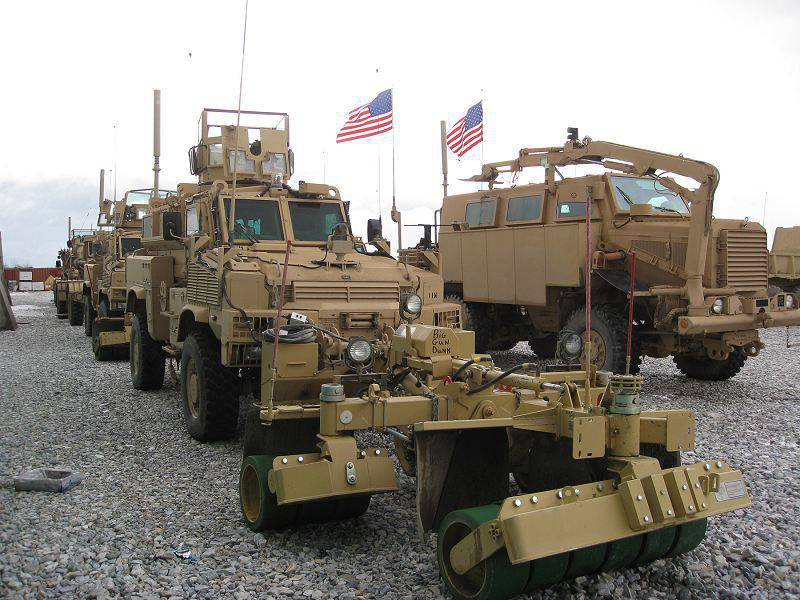
The JIEDDO organization of the US Department of Defense during the war in Iraq and Afghanistan helped quickly deploy equipment and equipment to combat IEDs, including these Marine Corps MRAP vehicles. The organization reduced its staff at the end of 2014 to 975 people
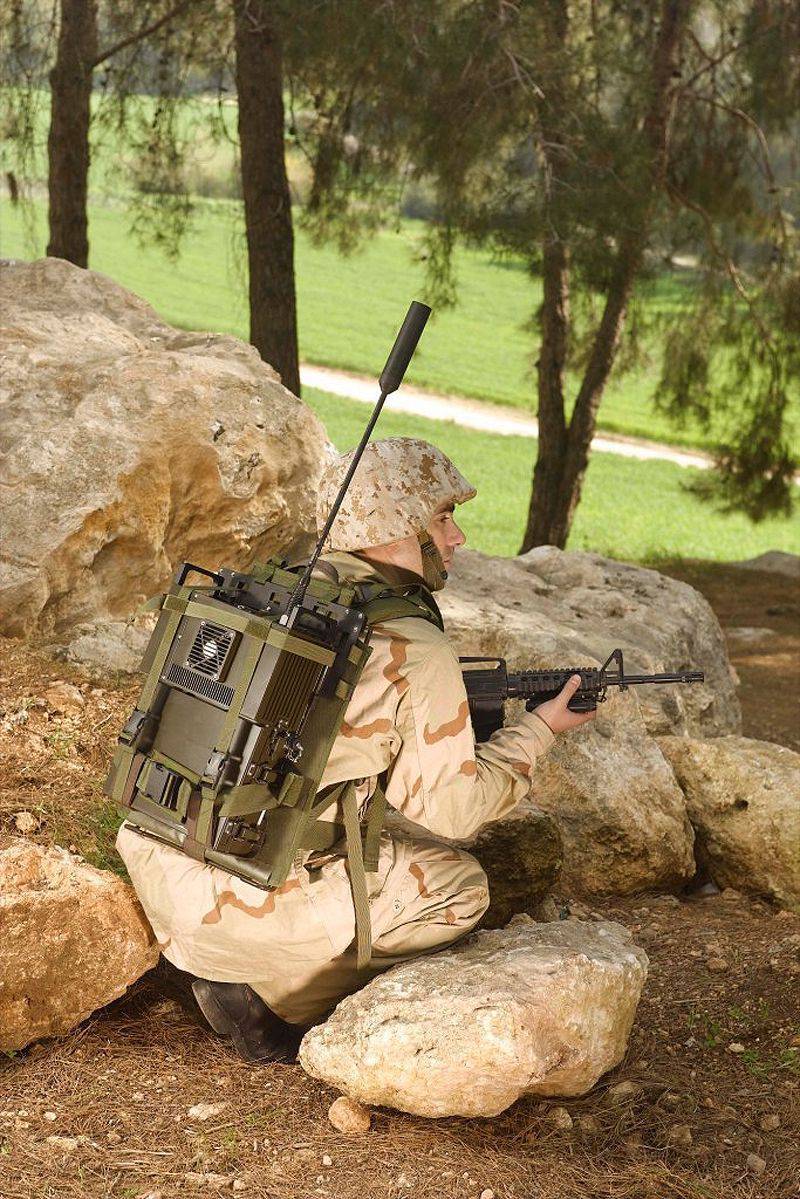
Elbit Systems miniature silencer will be refined in 2015 year according to user comments.
Neutralization of unexploded ordnance and explosive objects
Serious threats in the form of abandoned ammunition and minefields must be cleared not only for the safe movement of troops and in order to allow civilians to reoccupy areas full of deadly objects. The MINEWOLF platform (MW370), which combines a plowing trawl and a soil cutter, was deployed in Iraq to clear the oil fields from mines (mainly Valmara and VS50) of the Iran-Iraq war of the 80s. Demining of the Iraqi Majnoon field takes place in two stages: the ground is previously prepared by heavy armored bulldozers, which create strips of six meters in width and depth 40 cm, then MINEWOLF comes into play. The Mini-MINEWOLF system also participated in mine clearance in the Democratic Republic of the Congo. At IDEX 2013, the Micro-MINEWOLF (MW50) armored remote-controlled platform was shown, specifically designed to neutralize landmines, IEDs and clear routes in difficult terrain in harsh climatic conditions.
However, the most difficult problem in Afghanistan was the discovery of buried IEDs that do not contain or contain metal in minimal quantities. Next-generation machines should combine multi-sensor detection systems, night-vision equipment and subsurface radar (SPR). An SPR installed on machines with anti-explosion protection is designed to generate high-resolution 3D real-time images of changes in the ground from metal or as most often occurs in Afghan TVD plastic objects. The maximum working speed reached 10-15 km / h; it depends not only on the sensors used, but above all on the speed of signal processing. But since the average speed of military units is approximately 40 km / h, the working speed of the mine reconnaissance vehicles can be increased in remote control mode.
For hand-held mine detectors, the properties of the electromagnetic spectrum are currently being studied, which will help detect VCAs with minimal metal content, based on the acoustic properties of mines or in combination with GPR. Biological and chemical methods that will help detect bulk explosives based on their chemical properties are being investigated. A reliable warning signal should be issued at a safe distance, and mine detectors should reduce the frequency of false alarms without degrading the sensitivity level. In the area of demining systems, there are currently several trends: they must be modular, compatible with crew and crewless platforms, be able to adapt to many types of threats, and also have software that can be updated, thereby saving cost.
As a rule, an electronic stethoscope (or doppler meter) is used to neutralize existing ammunition, for example RE 80 M2 EST from Chemring. The device is a sensitive monitoring system for detecting electronic and mechanical timekeeping systems in IEDs and some munitions.
RE 80 M2 EST Electronic Stethoscope from Chemring
In the fight against IEDs, ground mobile robots provide invaluable assistance. They allow sappers (a specialty ammunition technical officer (ATO) - ammunition clearance technician) in the British Army to do their increasingly dangerous job in many battle zones where insurgents and terrorists are laying IEDs in urban areas and or as a means of blocking the zone. Mobile robots allow ATO technicians to be at a safe distance from the threat; the robot can examine and analyze the device before and after performing the neutralization procedure, quickly collecting and sorting out the information and sending it to the coordination center; it has various detonation devices for firing a “shot” inside the VCA and preventing the detonation of the main charge. Robots are used to precisely destroy the components of the VCA - an energy source, a detonator, sensors, and others. Thick-walled and thin-walled shells, along with “advanced” IEDs, can also be neutralized by undermining devices. The X-ray equipment of the robot must also provide sufficient detail for the detonation device, which can shoot a bomb with surgical precision.
For larger remote-controlled robots, mobility may be limited on rough terrain and therefore, to neutralize IEDs in hard-to-reach places, there is an increasing need for small robots that are controlled by a mother-robot. Future projects should be implemented on the basis of recommendations received from the main users - military units and the police for the disposal of explosive objects.
Materials used:
www.jieddo.mil
www.niitek.com
www.schiebel.net
www.ga.com
www.chemring.co.uk
www.csi.com
www.rafael.co.il
www.monch.com
en.wikipedia.org
www.airbusdefenceandspace.com
www.elbitsystems.com
www.minewolf.com

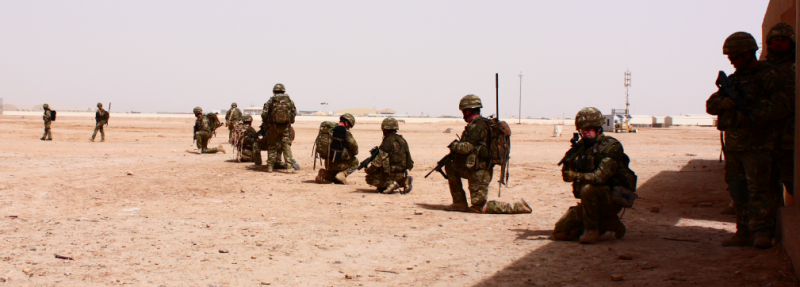

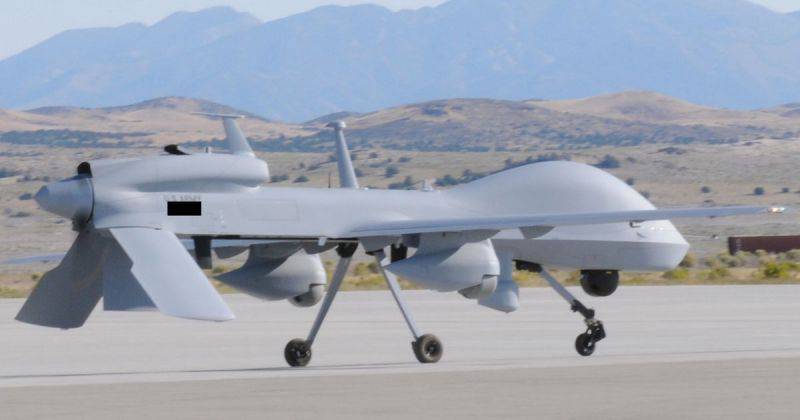
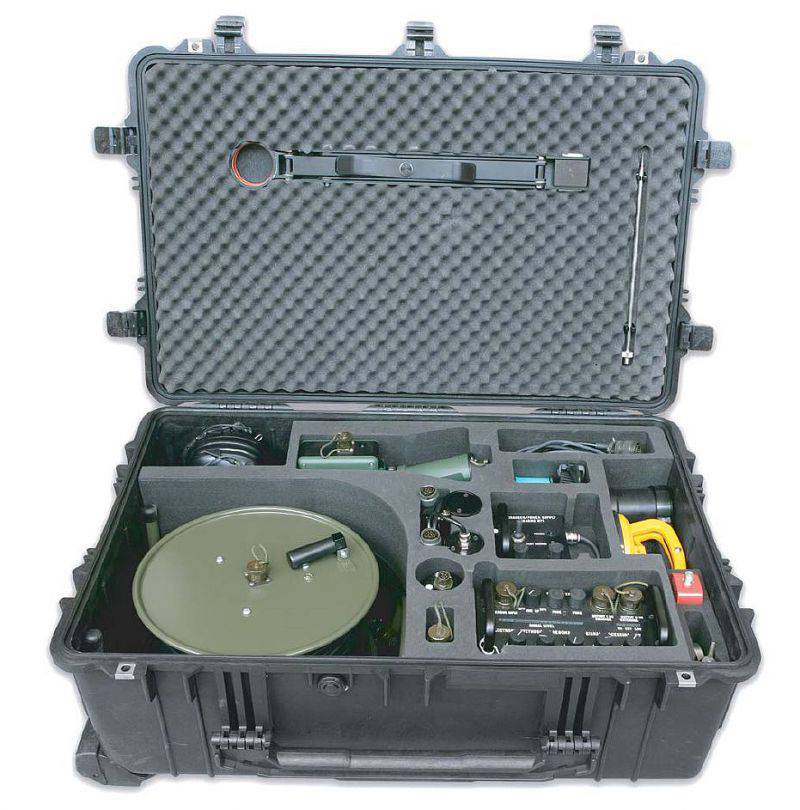
Information